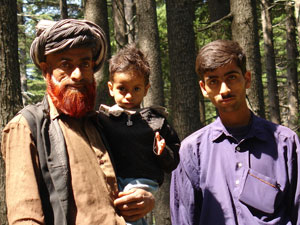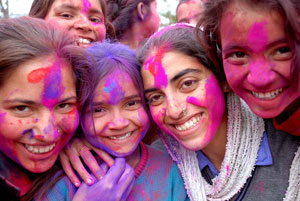|
|
|
|
Jammu |
|
General Information about Jammu
Area: 20.36 sq. kms
Altitude: 305 m
Temperature: Summer: Max. 43.0 Degree Celsius,
Min. 23.4 Degree Celsius; Winter: Max. 26.2 Degree
Celsius, Min. 4.3 Degree Celsius
Rainfall: 107 cms (July to September).
Best Season: September to April.
Clothing: Summer: light cottons, Winter: woolens
Languages: Dogri, Hindi, Punjabi, Urdu and
English |
 |
|
|
|
|
Information about Jammu
Jammu is the winter capital of the state of Jammu and Kashmir.
Nestled against the backdrop of the snow-capped Pir Panjal
Mountains, the region of Jammu constitutes the southernmost
unit of the state of Jammu and Kashmir. It is situated on the
banks of the Tawi river. Jammu was the homeland of the Dogras
who ruled over the entire state till 1947. Jammu is the second
largest city in the state. Jammu covers an area of 20.36
square kms and situated at an altitude of 305 metres. This
state holds the glorious history of the valiant kings,
calmness of the lakes, greenery of the forests and amazing
rivers. The city of Jammu, is the epicenter of all
socio-economic activities in the Jammu region. Although Jammu
is considered as a stopover point for moving to higher regions
of the Himalayas, there are some interesting places to visit
in Jammu. It is also the base for visiting various tourist and
pilgrimage places in which the region abounds. Jammu is often
known as the City of Temples due to the temples of Vaishno
Devi, Raghunath Temple and Rambireshwar Temple. The most
important pilgrimage centre is the shrine of Mata
Vaishnodeviji situated in the Trikuta hills at a distance of
60 kms from Jammu. Over 4.5 million pilgrims trek to this holy
cave shrine to pay obeisance to this most revered of Hindu
deities every year. Dogri, Hindi, Punjabi, Urdu and English
are the main languages which are spoken by the people in
Jammu. The best season to visit Jammu is between September and
April.
History of Jammu
According to legend, the city of Jammu was founded by the 9th
century king Jambu-lochan, after whom the city is named.
According to the legend, one day when he came upon a clearing
during the hunting trip, he saw a sight that left him
wonderstruck. A tiger and a goat stood side-by-side, drinking
water from the same place in the Tawi River. He was so struck
by this unusual sight that he decided to build a city on this
land where no living creature seemed to bear enmity towards
each other. This king is believed to have built the Bahu Fort
overlooking the Tawi river. Under the Akbar's policy of
conciliation and religious toleration, the Dogras became royal
feudatories of the Mughal emperors. In 1730 AD, it came under
the rule of the Dogra king, Raja Dhruv Deva. The Dogra rulers
moved their capital to the present site and Jammu became an
important centre of art and culture, especially the Pahari
school of paintings. Until the late 18th century, the fortunes
of Jammu were closely associated with the events in the
Punjab. During the rule of the Ranjit Singh, the Dogras of
Jammu were allowed a large degree of independence. Their ruler
was the Gulab Singh. At the close of the Sikh War in 1846 and
due to the treaty with the British he became the ruler of the
combined states of Jammu and Kashmir. During the 18th and 19th
centuries, there was a revival of arts, particularly in the
field of paintings, under the Dogra rulers. Gulab Singh also
wished to establish Jammu as a religious centre that compared
favourably with the Varanasi. He commissioned the Rambireshwar
temple, the largest Siva temple in north India. At partition,
Hari Singh, the Maharaja of Kashmir, decided to side with
India and as a result the state of Jammu and Kashmir was
created. |
| |
|
People of Jammu
Jammu region is home to several ethnic communities which
follow traditional life-styles with distinctive cultures
of their own. Among these communities, the Dogras
constitute the dominant group. They are mainly
concentrated in the outer hill and outer plain zones
covering Kathua, Udhampur and Jammu districts and the
lower parts of Rajouri district. A martial community by
tradition, their folklore centres on war heroes, both
legendary and historical. Even the region’s
architectural heritage, comprising elaborate castles and
hilltop fortifications that are visible |
 |
|
|
everywhere,
bespeak the community' s long-drawn preoccupation with battles
and ruling of distant lands. Yet the region’s history is not
completely bereft of traditions of art and culture. Thus,
while the troops fought battles in distant areas, the royalty
and the nobility nurtured art and culture. The Pahari
miniature paintings that have become famous throughout India,
are the finest examples of their artistic achievements. The
second largest ethnic group of the region is formed by the
Gujjars, a semi-nomadic people living along the hill slopes of
Doda and Rajouri districts while in Poonch they also dominate
the main valleys. Some of them have settled down to
agriculture, but the majority are primarily herdsmen. They
cultivate maize along the slopes of the mountains, but only as
a secondary occupation. The Bhalessa tract enveloping the
adjoining hills of Chamba in Himachal Pradesh, is inhabited by
the Gaddis, another semi-nomadic community, who graze immense
flocks of goats and sheep along the Himalayan slopes. As
summer draws on, the Gaddis move up the mountain pastures with
their flocks, and return to the lower area with the first
snowfall. Gaddis are generally associated with emotive music
played on the flute. The most interesting ethnic community,
however, is that of the Bakkarwals, a wholly nomadic pastoral
people who move all along the Himalayan slopes from the south
to the north, always in search of pastures for their huge
flocks of goat and sheep. Every summer, they move en-block
across the various mountain ranges as far as the Suru Valley
in the Ladakh region. They are an ancient people, the majority
following the lifestyle that their ancestors have been leading
throughout the ages. The Bakkarwals tend to sacrifice all
personal comforts for the welfare of their goats and sheep,
their economic mainstay.
Geography of Jammu
The Jammu region forms part of the transition between the
Himalayan range in the north and the dusty plains of Punjab in
the south. Between these two extremities lies a series of
scrub-covered hills, forested mountain ranges and river
valleys, encompassing several microclimatic regions that
extend from Kishtawar in the north-east to Akhnoor in the
south-west, and the historic town of Poonch in the north-west
to the borders of Kangra in the south-east. The Shivalik hills
cut across the area from the east to the west while the rivers
Ravi, Tawi and Chenab cut their way through the region.
Physically, the region of Jammu is not homogenous. It is
broadly divided into three zones determined by the terrain
condition and the geo-climatic environment. The southern-most
of these is the Outer Plains zone comprising of plains in
Jammu and Kathua districts which merge into the plains of
Punjab. Toward its north and north-east rises the Outer Hills
zone attaining height of 2000 to 4000 feet above mean sea
level. Basohli, Reasi and better parts of Rajouri district
fall in this zone. The landscape here shows open scrubs that
gradually thicken from low scrub to taller trees of acacias,
rhododendrons, cacti, etc. Above this zone, the terrain
becomes acute, the vegetal cover rich and the climatic
conditions salubrious. This is the region of the Middle
Himalayas comprising of several upland valleys of great
natural beauty such as Kishtawar, Bhaderwah, Poonch and higher
parts of Rajouri district. The average altitude of this zone
ranges from 8000 to 10,000 ft. The mountains here are covered
with thick forests of oak and chestnut, and higher up with
deodar and pine. The majestic Chenab drains this beautiful
landscape, carving spectacular gorges in its long and
serpentine course. Beyond and above the middle Himalayas lies
the Pir Panjal Range which separates Jammu province from the
Kashmir Valley. In the extreme north-east rises the Great
Himalayan Range itself, which forms a natural barrier between
the Kishtawar region of Jammu and the Suru-Zanskar area of the
Ladakh region. In its south-east to north-west sweeping arc,
the Great Himalayan Wall soars to a maximum height of 7,135 m
in the Nun-Kun massif, while dipping to 3,505 m at Zoji-la.
Between these two extremities, this mighty range rises into
dozens of perpetually snow-capped peaks and depresses into
several passes connecting the two contrasting environments on
its north and south. |
| |
|
Festivals in Jammu
Lohri and Baisakhi are the main festivals which are
celebrated in Jammu. Lohri is an important festival
which is celebrated throughout North India in the month
of January with havan and yagyas in temples and homes.
Baisakhi is the harvest festival celebrated in the month
of April. A large celebration is held at the Nagbani
temple. The Chaitre Chaudash mela is held during the
months of March-April at Uttar Behni, a village located
about 25 kms. from Jammu.
More.... |
 |
|
| |
|
Shopping in Jammu
The bazaars in Jammu are famous for Kashmiri handicrafts,
traditional Dogra jewellery and various dry fruits, chiefly
walnuts (‘akhrot’) and almonds. Jammu is also known for the
superlative quality of its ‘basmati’ rice, ‘rajma’ (red
beans), ‘ampapar’ (dried and candied mango peel), ‘anardana’
(dried pomegranate seeds) and ‘barfi’ (milk sweets). For
purchasing authentic Kashmiri handicrafts, one can visit the
Government Emporium. The emporium displays and sells a wide
variety of handicrafts, including Pashmina shawls and
exquisite hand-knotted carpets of silk and wool.
Tourist Attractions in Jammu
The city of Jammu comprises of two distinct parts which are
the Old Town that overlooks the Tawi river and the New Town.
Some of the famous tourist attractions in Jammu are the
Raghunath Temple, Bahu Fort, Art Gallery and Amar Mahal
Museum. The most outstanding landmark and famous tourist
attraction in Jammu is the Raghunath Temple. This temple is
dedicated to Lord Ram and is an impressive structure put up by
a devout king. The Amar Mahal Museum is more like a French
chateau with its sloping roofs and turrets. This museum has a
very large collection of royal miniature paintings,
manuscripts and the finest library of antique books. The Bahu
Fort is situated near the Amar Mahal museum. On the opposite
bank of the Tawi river, on an upland plateau, is situated the
majestic Bahu Fort, the oldest fort in the region.
More....
How to reach Jammu
By Air:
The Indian Airlines and Jet Airways daily operates flight
between Delhi, Jammu, Srinagar and Leh. The nearest
international airport is located at Jammu, about 8 kms away
from the city.
By Rail:
The nearest railway station is located at Jammu Tawi. Jammu
Tawi is an important railhead of the Northern India. Jammu is
well-connected with Mumbai, Delhi, Jaipur and Kolkata.
By Road:
Jammu is located on the national highway 1A (Jalandhar -
Srinagar - Uri) and is connected by the highway network to all
parts of the country. Jammu is connected to various
destinations in Jammu and Kashmir by all weather roads to
Katra, Pathankot, Kishtwar and to Ladakh via Srinagar from May
to October. |
|
